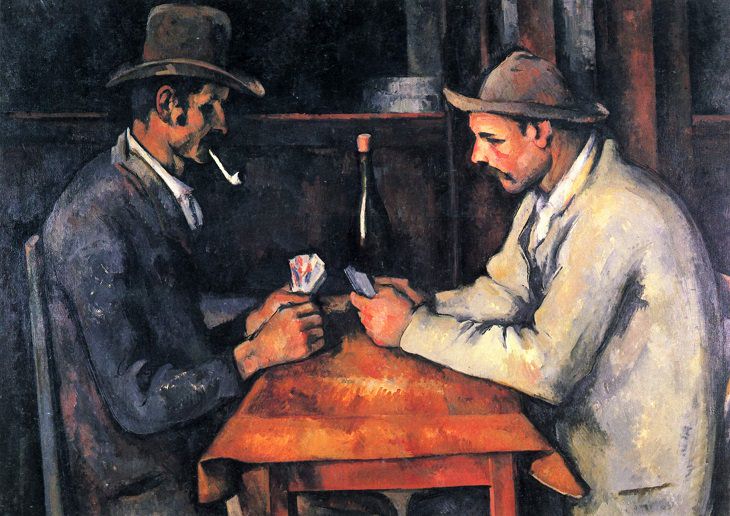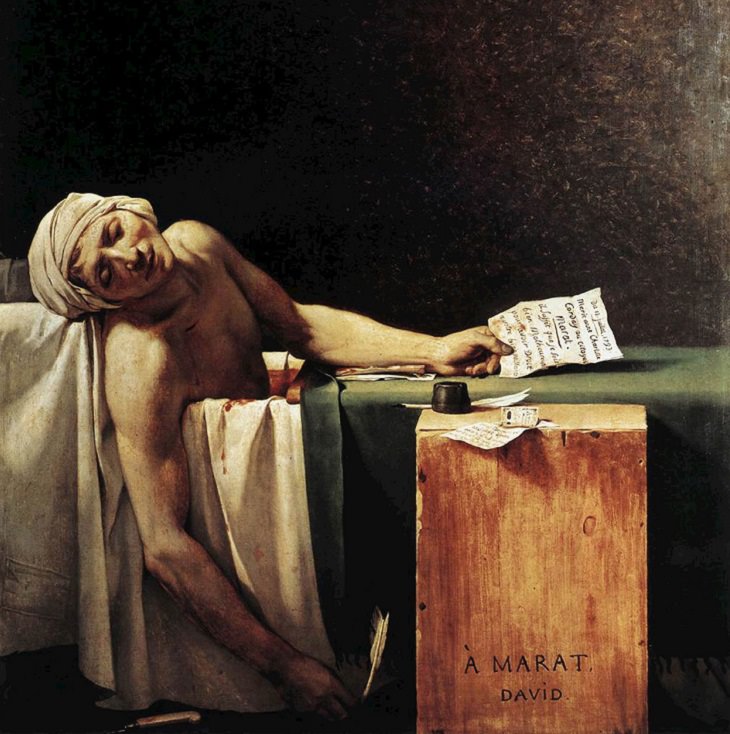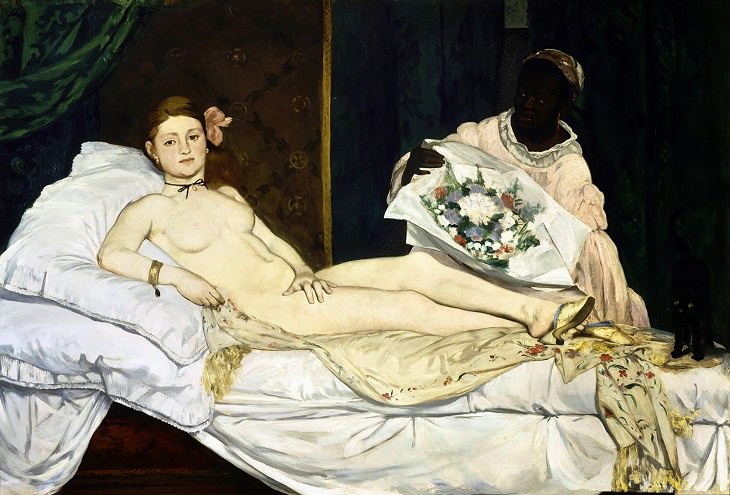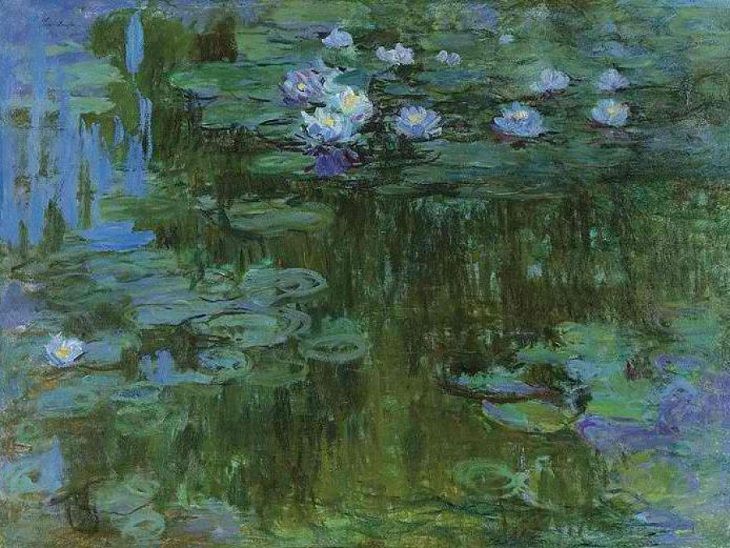

Artist: Paul Cézanne
Year: 1890s
This masterpiece of Post-Impressionist art was painted during the final period of Paul Cézanne’s work, which is considered his best period. The painting depicts Provencal peasants engrossed in playing cards and smoking their pipes. They are noted for their lack of drama, narrative, and conventional characterization.
Back in 2011, one version of the “The Card Players” was sold for more than $250 million, making it the most expensive piece of art ever sold. It held this record until February 2015 when Ganguin’s “When Will You Marry?” sold for around $300 million.

Artist: Jacques-Louis David
Year: 1793
Jean-Paul Marat was a journalist and politician who was a radical voice of the French Revolution. One of his papers, L'Ami du Peuple (Friend of the People), was the most celebrated radical publication of the revolution, but it was considered by some to be reckless as it instigated violence and rebellious behavior.
Charlotte Corday, who came from a minor aristocratic family, blamed Marat for the September Massacre during the Reign of Terror. She gained entrance to his room on the pretext that she had information on counter-revolutionary activities. Marat, who had to spend a lot of time in his bath due to a skin condition, was fatally stabbed by Charlotte on 13th July 1793. She was later tried and executed. This painting, which shows the radical journalist lying dead in his bath, is one of the most famous pictures of the French Revolution.

Artist: Georges Seurat
Year: 1884-86
Seurat was an innovative artist who devised two prominent painting techniques known as pointillism and chromoluminarism. This painting is the most well-known and one of the best examples of pointillism, a style in which small, distinct dots of pure color are applied in patterns to form an image.
Seurat spent two years on this work, creating a number of sketches of the various figures in order to perfect their form. A Sunday Afternoon is considered to be Seurat’s masterpiece. More importantly, it’s regarded as a milestone of late 19th century art as it altered the direction of art by initiating Neo-Impressionism, an important early artistic movement of the modern era.

Artist: Henri Matisse
Year: 1910
Along with Duchamp and Picasso, Matisse is considered one of the most influential figures of modern art. This painting was created by Matisse as part of a two-painting commission for Russian art collector, Sergei Shchukin. It shows five dancing figures, painted in a strong red, against a simplified green landscape and deep blue sky.
The painting has been deliberately painted in an unsophisticated and childish way. La Danse is considered to be a key point in the development of modern painting, and remains highly influential to this day.

Artist: Claude Monet
Year: 1872
This painting is famous for giving a name to the Impressionist movement, and it has now become its quintessential symbol. It was not well taken by critics at the time, and the term Impressionist was coined in a satirical review by Louis Leroy.
However, this movement soon became so popular that it spread to music and literature as well. The subject of this painting is the harbor of Le Havre in France. Monet uses color as the main factor to capture the very essence of the scene.

Artist: Théodore Géricault
Year: 1819
Méduse was a French warship which fought in the Napoleonic Wars. Though it survived the wars, it crashed into a sandbank in July 1816 while transporting people to Senegal. The 400 people on board had to evacuate; out of which 151 were put on a raft. The men on this raft had to undergo a terrible ordeal. Many were washed into the sea by fearsome storms, others rebelled and were killed by officers, while the survivors had to resort to cannibalism to survive.
After nearly two weeks at sea, the raft was found, but only 15 men had survived. The whole event became an international scandal. Théodore Géricault studied the incident before deciding to create his masterpiece. This work is now considered to be an iconic work of French Romanticism, and it has immortalized the incident that it depicts.

Artists: Pierre-Auguste Renoir
Year: 1876
This painting depicts a Sunday afternoon at Moulin de la Galette in the district of Montmartre in 19th Century Paris. Moulin de la Galette was an open-air dancehall and café that was close to Renoir’s home. He frequently attended dances at this café and enjoyed watching the happy couples.
In this painting, Renoir masterfully links the art of collective portrait, landscape painting, and still life. This was Renoir’s most ambitious figure painting and no artist before him had created a canvas of this magnitude for capturing an aspect of daily life. This has been described by some as one of the most beautiful paintings of the 19th century.

Artist: Édouard Manet
Year: 1863
When it was first exhibited at the 1865 Paris Salon, it caused a huge controversy; not because of Olympia’s nudity, but because there are a number of details in the painting that suggests she is a prostitute. These include the orchid in her hair, pearl earrings, her bracelet, and the oriental shawl on which she lies.
Furthermore, there is a black cat in the painting, which traditionally symbolizes prostitution. The most famous aspect of this painting is the confrontational gaze of Olympia, which is often-referenced as the pinnacle of defiance towards patriarchy.

Artist: Eugène Delacroix
Year: 1830
Liberty has existed as a goddess in many cultures, and during the French Revolution many allegorical personifications of Liberty appeared in France. Since then, the figure of Liberty is viewed as a symbol of France and the French Republic.
This painting commemorates the July Revolution of 1830 in which King Charles X of France was overthrown. It shows Liberty as a goddess and a robust woman of the people. She holds the French flag in one hand and a firearm in the other. Delacroix is regarded as the leading French Romantic painter.

Artist: Claude Monet
Year: 1896-1926
Monet's “Nympheas” series consists of approximately 250 oil paintings which were created by him during the last 30 years of his life. They can now be found on display all over the world. The dazzling complexity of color and light in the panels opens the viewer’s eyes to the incredible diversity of nature and to the depth and mystery of the life it sustains.
What’s amazing about these works is that Monet’s eyesight was badly deteriorating due to cataracts when he painted most of these masterpieces. Monet’s water-lily paintings are among the most recognized and celebrated works of the 20th century and they hugely influenced the generations of artists that followed him. In fact, they have been described as “The Sistine Chapel of Impressionism."
Source: learnodo-newtonic
Related Articles:
18 Famous Renoir Paintings That Will Take Your Breath Away
The Legacy of the Dutch Masters of Art